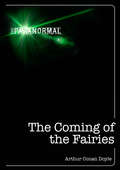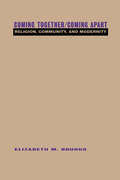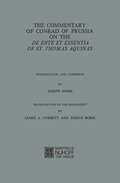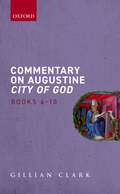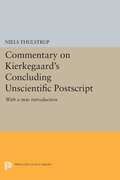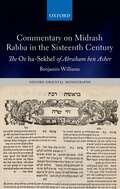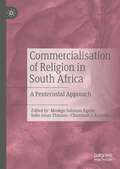- Table View
- List View
The Coming of the Fairies (The Paranormal)
by Arthur Conan DoyleSir Arthur Conan Doyle (1859-1930), best known as the author of Sherlock Holmes stories but also a devout spiritualist, was entirely convinced by a set of photographs apparently showing two young girls from Cottingley in Yorkshire playing with a group of tiny, translucent fairies. To demonstrate his unshakeable belief in the spirit world, he published The Coming of the Fairies in 1922. Doyle’s book lays out the story of the photographs, their supposed provenance, and the implications of their existence.Featuring an original extract from a 1920 article from The Liverpool Echo about Doyle and the fairy photographs, this quirky and fascinating book allows us to get inside the mind of an intelligent, highly respected man who happened to believe in fairies.The Paranormal, the new ebook series from F&W Media International Ltd, resurrecting rare titles, classic publications and out-of-print texts, as well as new ebook titles on the supernatural-other-worldly books for the digital age. The series includes a range of paranormal subjects from angels, fairies and UFOs to near-death experiences, vampires, ghosts and witchcraft.
The Coming of the Friars
by Rosalind B. BrookeOriginally published in 1975, this book helps students understand why the Movements of the 12th century remained much more enclosed and monastic or turned to heresy; How much the new orders of Friars owed to the earlier movements and to what extent they arose from the personal inspiration of Saint Francis and Saint Dominic. The introduction is arranged to help the documents to speak for themselves: it opens with a direct confrontation with Francis then goes back to search the religious experience of the 10th to 12th centuries for movements and especially well documented individuals who can help explain the development of fashions and ideas. There are sections on precursors, both monks and heretics, and on the papal policies towards these movements, and the introduction closes with a chapter on Dominic and an epilogue on the impact of the Friars.
The Coming of the Friars
by Rosalind B. BrookeOriginally published in 1975, this book helps students understand why the Movements of the 12th century remained much more enclosed and monastic or turned to heresy; How much the new orders of Friars owed to the earlier movements and to what extent they arose from the personal inspiration of Saint Francis and Saint Dominic. The introduction is arranged to help the documents to speak for themselves: it opens with a direct confrontation with Francis then goes back to search the religious experience of the 10th to 12th centuries for movements and especially well documented individuals who can help explain the development of fashions and ideas. There are sections on precursors, both monks and heretics, and on the papal policies towards these movements, and the introduction closes with a chapter on Dominic and an epilogue on the impact of the Friars.
The Coming of the Mongols (The Idea of Iran #7)
by David O. Morgan Sarah StewartThe Mongol invasions in the first half of the thirteenth century led to profound and shattering changes to the historical trajectory of Islamic West Asia. As this new volume in The Idea of Iran series suggests, sudden conquest from the east was preceded by events closer to home which laid the groundwork for the later Mongol success. In the mid-twelfth century the Seljuq empire rapidly unravelled, its vast provinces fragmenting into a patchwork of mostly short-lived principalities and kingdoms. In time, new powers emerged, such as the pagan Qara-Khitai in Central Asia; the Khwarazmshahs in Khwarazm, Khorosan and much of central Iran; and the Ghurids to the southeast. Yet all were blown away by the Mongols, who faced no resistance from a sufficiently muscular imperial competitor and whose influx was viewed by contemporaries as cataclysmic. Distinguished scholars including David O Morgan and the late C E Bosworth here discuss the dynasties that preceded the invasion – and aspects of their literature, poetry and science – as well as the conquerors themselves and their rule in Iran from 1219 to 1256.
Coming Out Christian in the Roman World: How the Followers of Jesus Made a Place in Caesar’s Empire
by Douglas Ryan BoinThe supposed collapse of Roman civilization is still lamented more than 1,500 years later-and intertwined with this idea is the notion that a fledgling religion, Christianity, went from a persecuted fringe movement to an irresistible force that toppled the empire. The "intolerant zeal†? of Christians, wrote Edward Gibbon, swept Rome's old gods away, and with them the structures that sustained Roman society. Not so, argues Douglas Boin. Such tales are simply untrue to history, and ignore the most important fact of all: life in Rome never came to a dramatic stop. Instead, as Boin shows, a small minority movement rose to transform society-politically, religiously, and culturally-but it was a gradual process, one that happened in fits and starts over centuries. Drawing upon a decade of recent studies in history and archaeology, and on his own research, Boin opens up a wholly new window onto a period we thought we knew. His work is the first to describe how Christians navigated the complex world of social identity in terms of "passing†? and "coming out.†? Many Christians lived in a dynamic middle ground. Their quiet success, as much as the clamor of martyrdom, was a powerful agent for change. With this insightful approach to the story of Christians in the Roman world, Douglas Boin rewrites, and rediscovers, the fascinating early history of a world faith.
Coming to the Edge of the Circle: A Wiccan Initiation Ritual (AAR Academy Series)
by Nikki BadoImagine yourself sitting on the cool damp earth, surrounded by deep night sky and fields full of fireflies, anticipating the ritual of initiation that you are about to undergo. Suddenly you hear the sounds of far-off singing and chanting, drums booming, rattles "snaking," voices raised in harmony. The casting of the Circle is complete. You are led to the edge of the Circle, where Death, your challenge, is waiting for you. With the passwords of "perfect love" and "perfect trust" you enter Death's realm. The Guardians of the four quarters purify you, and you are finally reborn into the Circle as a newly made Witch. Coming to the Edge of the Circle offers an ethnographic study of the initiation ritual practiced by one coven of Witches located in Ohio. As a High Priestess within the coven as well as a scholar of religion, Nikki Bado is in a unique position to contribute to our understanding of this ceremony and the tradition to which it belongs. Bado's analysis of this coven's initiation ceremony offers an important challenge to the commonly accepted model of "rites of passage." Rather than a single linear event, initiation is deeply embedded within a total process of becoming a Witch in practice and in community with others. Coming to the Edge of the Circle expands our concept of initiation while giving us insight into one coven's practice of Wicca. An important addition to Ritual Studies, it also introduces readers to the contemporary nature religion variously called Wicca, Witchcraft, the Old Religion, or the Craft.
Coming Together/Coming Apart: Religion, Community and Modernity
by Elizabeth BoundsThe idea of "community" is increasingly vital to our individual and social well-being. Yet at the same time, our ordinary communal relations are being eroded by increased social and geographical mobility, lost traditions, and the growing pluralism of society. Examining this renewed desire for community, Coming Together/Coming Apart locates the current problems of society in the conditions of modern capitalism. Arising out of a common matrix of a world in crisis, contemporary religious, social and feminist discussions of community compose an ideological struggle over the reformation of society.
Coming Together/Coming Apart: Religion, Community and Modernity
by Elizabeth BoundsThe idea of "community" is increasingly vital to our individual and social well-being. Yet at the same time, our ordinary communal relations are being eroded by increased social and geographical mobility, lost traditions, and the growing pluralism of society. Examining this renewed desire for community, Coming Together/Coming Apart locates the current problems of society in the conditions of modern capitalism. Arising out of a common matrix of a world in crisis, contemporary religious, social and feminist discussions of community compose an ideological struggle over the reformation of society.
Command and Creation: A Persian edition and English translation of Muhammad al-Shahrastani’s Majlis-i maktub (Ismaili Texts and Translations)
by Daryoush Mohammad PoorAmong the considerable oeuvre of Muhammad al-Shahrastani (1086–1153), the prominent Persian theologian and heresiographer, the Majlis-i maktub ('The Transcribed Sermon') is his only known work in Persian. First delivered as a sermon in Khwarazm in Central Asia, this treatise invokes the theme of creation and command, providing an esoteric cosmological narrative where faith, revelation, prophecy and the spiritual authority of the Household of the Prophet are interwoven. The Majlis-i maktub further discusses themes such as the evolution of religious law (shari'at) and its culmination in the qiyamat (resurrection), the relation between free will and predestination, the interplay between the exoteric and esoteric aspects of faith, and the role and function of the Shi?i Imams in the cosmological narrative.This treatise is arguably the most dense expression of al-Shahrastani's thought, and it demonstrably indicates the Ismaili inclination of this Muslim scholar who has usually been regarded as a Shafi'i-Ash'ari. Daryoush Mohammad Poor's comparative study of this treatise and the corpus of Nizari Ismaili literature from the Alamut period (1090–1256) reveals the massive impact of al-Shahrastani's thought on every aspect of the doctrines of Nizari Ismailis.
Command and Creation: A Persian edition and English translation of Muhammad al-Shahrastani’s Majlis-i maktub (Ismaili Texts and Translations)
by Daryoush Mohammad PoorAmong the considerable oeuvre of Muhammad al-Shahrastani (1086–1153), the prominent Persian theologian and heresiographer, the Majlis-i maktub ('The Transcribed Sermon') is his only known work in Persian. First delivered as a sermon in Khwarazm in Central Asia, this treatise invokes the theme of creation and command, providing an esoteric cosmological narrative where faith, revelation, prophecy and the spiritual authority of the Household of the Prophet are interwoven. The Majlis-i maktub further discusses themes such as the evolution of religious law (shari'at) and its culmination in the qiyamat (resurrection), the relation between free will and predestination, the interplay between the exoteric and esoteric aspects of faith, and the role and function of the Shi?i Imams in the cosmological narrative.This treatise is arguably the most dense expression of al-Shahrastani's thought, and it demonstrably indicates the Ismaili inclination of this Muslim scholar who has usually been regarded as a Shafi'i-Ash'ari. Daryoush Mohammad Poor's comparative study of this treatise and the corpus of Nizari Ismaili literature from the Alamut period (1090–1256) reveals the massive impact of al-Shahrastani's thought on every aspect of the doctrines of Nizari Ismailis.
The Command of Grace: A New Theological Apologetics
by Paul D. JanzThe Command of Grace sets forth a bold new critical initiative in theological apologetics, one that advances a fundamental reassessment of theological self-understanding and method today, especially in its attentiveness to the present reality of God in revelation. Many recent, predominating trends have tended to treat theological truth as something cognitively self-guaranteeing ('tauto-theological') within doctrinal or other theoretical domains. Against this, and drawing on the philosophical heritage and Jewish thought, the book seeks to revive other basic modes of human attentiveness for fundamental theological questioning. These are: 'causal' attentiveness encountered through the faculties of bodily sensibility; and 'appetitive' or 'motive' attentiveness encountered in the faculty of desire. Especially crucial here is the rejuvenation of the primacy of 'motive reasoning' (reasoning with regard to motivations and desires) for theology's apologetical self-understanding, in addition to its normal engagement with 'cognitive reasoning' (reasoning with regard to percepts and concepts). If God in his transcendent 'Godness' meets us in revelation not at the margins of the speculative intellect in the form of a denotatum for cognitive apprehension, but rather at the very centre of embodied life in the form of a summons to motivated action, then theology must seek to be attentive to God through all the endowed faculties of embodied-rational life: cognitive, sensible, and motive-appetitive.
Commandos for Christ
by Bruce E. PorterfieldBRUCE PORTERFIELD spent three terms in Bolivia with the New Tribes Mission. Much of his time there was spent with other missionaries in seeking to make a friendly contact with primitive tribes in remote areas of the country. The story of this work is told in Commandos for Christ. "For a few minutes we waited in the deep shadows on the edge of the jungle. A deathly stillness lay over everything. After what seemed a lifetime, I was unable to bear the suspense any longer. I let out a lusty shout. At the far side of the clearing an Indian appeared. Quite tall, with long black hair and fierce black eyes, he was altogether naked. In one hand he held a long bow and about a dozen arrows. We stared at each other without moving. What a moment that was! Before us stood the first living aboriginal Indian we had ever seen. He must have looked exactly as his primitive ancestors did. I felt he and I were staring at each other across three thousand years____" This is typical of the tight situations in which Bruce Porterfield and his colleagues found themselves day after day
Commemoration and Bloody Sunday: Pathways of Memory (Palgrave Macmillan Memory Studies)
by B. ConwayIn this wide-ranging study of the politics of memory in Northern Ireland, Brian Conway examines the 'career' of the commemoration of Bloody Sunday, and looks at how and why the way this historic event is remembered has undergone change over time. Drawing on original empirical data, he provides new insights into the debate on collective memory.
Commemorative Identities: Jewish Social Memory and the Johannine Feast of Booths (The Library of New Testament Studies #396)
by Mary B. SpauldingCommemorative Identities represents a significantly new approach to the issue of replacement/abrogation vs. continuation of Jewish thought patterns and practices among Jewish Christ-followers as they are addressed by the Johannine author. Previous studies have been unable to elucidate a comprehensible argument to support continuation of commemoration in the face of explicit Temple replacement terminology in the Gospel. This study provides that argument based upon known sociological observations and models, and direct comparative analysis with Jewish practices pre- and post-70. Mary Spaulding's study will further invigorate scholarly debate concerning identity issues in the Fourth Gospel, a topic of significant interest among Johannine scholars today. More generally, the origins of Christianity as portrayed in the Gospel of John are understood as a gradual unfolding of and differentiation among various Jewish groups post-Second Temple rather than as an abrupt break from an established, normative Judaism.
The Commentary of Conrad of Prussia on the De Ente et Essentia of St. Thomas Aquinas: Introduction and Comments
by Conradus de PrussiaCommentary on Augustine City of God, Books 6-10
by Gillian ClarkThis is the second volume in a series of commentaries on Augustine's City of God (De civitate Dei). Books 6-10 are Augustine's answer to those who think that many gods should be worshipped for blessings in the life to come. In Books 1-5 he had replied to those who thought many gods should be worshipped for blessings in this mortal life; he expected this next task to be more challenging, because he must engage with outstanding philosophers who have much in common with Christians. In Books 6-10, he makes the task manageable by selecting very short extracts, all in Latin, from his target authors: on interpretations of Roman myth and cult (books 6-7) the learned Varro, Divine Matters, and Seneca On Superstition; on daimones (Books 8-9) Apuleius, On the God of Socrates, and Asclepius, ascribed to Hermes Trismegistus; on Platonist philosophy (Book 10) translated quotations from Plotinus and Porphyry. Augustine aims to show that the many gods are deceptive demons who want worship for themselves and cannot mediate between mortals and the immortal divine. Especially in Book 10, he contrasts these demons with the good angels who want us to be blessed as they are by worshipping the true God, and with the true mediator Jesus Christ who in his incarnation united humanity with God. Platonist philosophers, Augustine argues, despise the body and aspire to reach the divine by superior intellect; for ordinary people they offer only theurgy, which is dangerous magic. But Christian faith is accessible to all. The coming of Christ and the Church is revealed by the true God in divinely inspired scripture, and Christian worship unites the believer with the self-offering of Christ. Augustine is now ready to move to the second part of City of God, on the origin, course and due ends of the two cities--the city of God and the earthly city--which are intertwined in this world.
Commentary on Augustine City of God, Books 6-10
by Gillian ClarkThis is the second volume in a series of commentaries on Augustine's City of God (De civitate Dei). Books 6-10 are Augustine's answer to those who think that many gods should be worshipped for blessings in the life to come. In Books 1-5 he had replied to those who thought many gods should be worshipped for blessings in this mortal life; he expected this next task to be more challenging, because he must engage with outstanding philosophers who have much in common with Christians. In Books 6-10, he makes the task manageable by selecting very short extracts, all in Latin, from his target authors: on interpretations of Roman myth and cult (books 6-7) the learned Varro, Divine Matters, and Seneca On Superstition; on daimones (Books 8-9) Apuleius, On the God of Socrates, and Asclepius, ascribed to Hermes Trismegistus; on Platonist philosophy (Book 10) translated quotations from Plotinus and Porphyry. Augustine aims to show that the many gods are deceptive demons who want worship for themselves and cannot mediate between mortals and the immortal divine. Especially in Book 10, he contrasts these demons with the good angels who want us to be blessed as they are by worshipping the true God, and with the true mediator Jesus Christ who in his incarnation united humanity with God. Platonist philosophers, Augustine argues, despise the body and aspire to reach the divine by superior intellect; for ordinary people they offer only theurgy, which is dangerous magic. But Christian faith is accessible to all. The coming of Christ and the Church is revealed by the true God in divinely inspired scripture, and Christian worship unites the believer with the self-offering of Christ. Augustine is now ready to move to the second part of City of God, on the origin, course and due ends of the two cities--the city of God and the earthly city--which are intertwined in this world.
Commentary on Kierkegaard's "Concluding Unscientific Postscript": With a new introduction (PDF)
by Niels Thulstrup Robert J. WidenmannIn the first comprehensive commentary on Soren Kierkegaard's Concluding Unscientific Postscript the eminent Kierkegaard specialist Niels Thulstrup clarifies the book's intricate allusions to the thought and literature of its own and past ages. A central work both in Kierkegaard's authorship and in the history of philosophy, the Postscript breaks completely with a long tradition of religious and philosophical thought. In his introduction and commentary, presented here in translation from the Danish, Professor Thulstrup explains this break and the unique relationship of the work to Kierkegaard's other books.Originally published in 1984.The Princeton Legacy Library uses the latest print-on-demand technology to again make available previously out-of-print books from the distinguished backlist of Princeton University Press. These editions preserve the original texts of these important books while presenting them in durable paperback and hardcover editions. The goal of the Princeton Legacy Library is to vastly increase access to the rich scholarly heritage found in the thousands of books published by Princeton University Press since its founding in 1905.
Commentary on Midrash Rabba in the Sixteenth Century: The Or ha-Sekhel of Abraham ben Asher (Oxford Oriental Monographs)
by Benjamin WilliamsPrinted editions of midrashim, rabbinic expositions of the Bible, flooded the market for Hebrew books in the sixteenth century. First published by Iberian immigrants to the Ottoman Empire, they were later reprinted in large numbers at the famous Hebrew presses of Venice. This study seeks to shed light on who read these new books and how they did so by turning to the many commentaries on midrash written during the sixteenth century. These innovative works reveal how their authors studied rabbinic Bible interpretation and how they anticipated their readers would do so. Benjamin WIlliams focuses particularly on the work of Abraham ben Asher of Safed, the Or ha-Sekhel (Venice, 1567), an elucidation of midrash Genesis Rabba which contains both the author's own interpretations and also the commentary he mistakenly attributed to the most celebrated medieval commentator Rashi. Williams examines what is known of Abraham ben Asher's life, his place among the Jewish scholars of Safed, and the publication of his book in Venice. By analysing selected passages of his commentary, this study assesses how he shed light on rabbinic interpretation of Genesis and guided readers to correct interpretations of the words of the sages. A consideration of why Abraham ben Asher published a commentary attributed to Rashi shows that he sought to lend authority to his programme of studying midrash by including interpretations ascribed to the most famous commentator alongside his own. By analysing the production and reception of the Or ha-Sekhel, therefore, this work illuminates the popularity of midrash in the early modern period and the origins of a practice which is now well-established-the study of rabbinic Bible interpretation with the guidance of commentaries.
Commentary on Midrash Rabba in the Sixteenth Century: The Or ha-Sekhel of Abraham ben Asher (Oxford Oriental Monographs)
by Benjamin WilliamsPrinted editions of midrashim, rabbinic expositions of the Bible, flooded the market for Hebrew books in the sixteenth century. First published by Iberian immigrants to the Ottoman Empire, they were later reprinted in large numbers at the famous Hebrew presses of Venice. This study seeks to shed light on who read these new books and how they did so by turning to the many commentaries on midrash written during the sixteenth century. These innovative works reveal how their authors studied rabbinic Bible interpretation and how they anticipated their readers would do so. Benjamin WIlliams focuses particularly on the work of Abraham ben Asher of Safed, the Or ha-Sekhel (Venice, 1567), an elucidation of midrash Genesis Rabba which contains both the author's own interpretations and also the commentary he mistakenly attributed to the most celebrated medieval commentator Rashi. Williams examines what is known of Abraham ben Asher's life, his place among the Jewish scholars of Safed, and the publication of his book in Venice. By analysing selected passages of his commentary, this study assesses how he shed light on rabbinic interpretation of Genesis and guided readers to correct interpretations of the words of the sages. A consideration of why Abraham ben Asher published a commentary attributed to Rashi shows that he sought to lend authority to his programme of studying midrash by including interpretations ascribed to the most famous commentator alongside his own. By analysing the production and reception of the Or ha-Sekhel, therefore, this work illuminates the popularity of midrash in the early modern period and the origins of a practice which is now well-established-the study of rabbinic Bible interpretation with the guidance of commentaries.
A Commentary on the Gospel of Thomas: From Interpretations to the Interpreted (Jewish and Christian Texts)
by Petr PokornýThis commentary is opened by a study offering information about all aspects of the Gospel of Thomas, especially about its relation to other texts of early Christian literature, including the canonical Gospels. The successive commentary is based upon the Coptic version and discusses also all fragments of the original Greek text. The volume is divided into two parts: The first discusses the function of each logion (saying) within the frame of piety and theology of the Thomasine group, for which the Gospel is composed; The second part discusses its literary shape and its history, including its relation to the historical Jesus. The result is a portrait of the Gospel as a radical interpretation of Jesus' heritage, still preserving some forgotten features of his teaching.
A Commentary on the Gospel of Thomas: From Interpretations to the Interpreted (Jewish and Christian Texts)
by Petr PokornýThis commentary is opened by a study offering information about all aspects of the Gospel of Thomas, especially about its relation to other texts of early Christian literature, including the canonical Gospels. The successive commentary is based upon the Coptic version and discusses also all fragments of the original Greek text. The volume is divided into two parts: The first discusses the function of each logion (saying) within the frame of piety and theology of the Thomasine group, for which the Gospel is composed; The second part discusses its literary shape and its history, including its relation to the historical Jesus. The result is a portrait of the Gospel as a radical interpretation of Jesus' heritage, still preserving some forgotten features of his teaching.
Commercialisation of Religion in South Africa: A Pentecostal Approach
by Mookgo Solomon Kgatle Jonas Sello Thinane Chammah J. KaundaAspects of the 2017 Final Report of the South African Commission on the Promotion and Protection of the Rights of Cultural, Religious and Linguistic Communities (CRL) have drawn strong criticism, particularly from South African scholars, politicians and the public. The criticism is largely regarding the constitutionality of its recommendation, which calls for regulation of the Religion to combat its abuse and commercialization. Scholars have criticized the CRL Rights Commission for hastening its investigation and releasing the final report without having a substantive understanding of what is meant by the commercialization of religion, and consequently the unconstitutional implications of the recommendation, to regulate religion. A close reading of this critique has pointed to the urgent need to assemble a cumulative body of research that examines and advances understanding of what is meant by the commercialization of religion. Accordingly, this book gathers scholarly contributionswhich offer valuable insights into the basics of what is meant by the commercialization of religion. Contributors examine this phenomenon from the historical roots to the manifestation in the contemporary world, particularly in South Africa.
Committed Life: An Adaptation of The Introduction to the Devout Life by St. Francis de Sales
by William MeningerA masterful updating of a classic work.St. Francis de Sales (1567-1622), bishop of Geneva and founder of the Visitation Order of nuns, was renowned for his teachings on spirituality. His masterpiece in the field of spiritual literature was "The Introduction to the Devout Life." Revolutionary in its day and noted for its charm, warmth, and clarity of language, it set forth a spirituality oriented toward life in the world, an approach quite different from that of St. Francis de Sales's contemporaries,who saw spiritual perfection as possible only in religious life.While the message of "The Introduction to Devout Life" is still valid today, the fact is that its expression is quite dated. In this book, as in "Bringing 'The Imitation of Christ' Into the 21st Cemtury," Father Meninger is not offering a new translation or paraphrase of a spiritual classic. Rather, he is attempting to express the teachings of the original in a wholly contemporary idiom. Father Meninger has not hesitated to change, omit, or add to the original where necessary, the better to highlight the heart and charisma of St. Francis de Sales's teachings.
